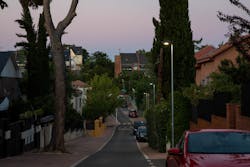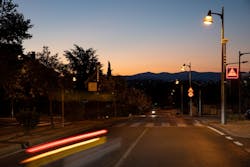Hillsboro, VA, some 50 miles outside of Washington, DC, has used the downtime enforced by the pandemic to remake its spot along what has been a busy commuter roadway. Moreover, the small town is proof of the affordability of connected solid-state lighting (SSL) as the project included Bluetooth-based LED luminaires along the center of town. Meanwhile, Tridonic has supplied another European project with smart outdoor SSL with Pozuelo de Alarcón in Spain connecting 2700 outdoor nodes.
Make a city small again
Apparently, Hillsboro, VA had become the antithesis of what you would expect of a small country town an hour drive from a major city. The less than one-mile stretch of Route 9 in the center of town had become unsafe for walking with the lack of infrastructure such as sidewalks and commuters speeding through the village. The city leaders used the slowdown of the pandemic to remake the stretch, applying for various grants that enabled construction of sidewalks, placing utilities underground, retrofit of the wastewater system, and the construction of traffic circles at either end of the center stretch to slow traffic. The Washington Post published an article about the complete transformation and the positive impact it has made on the citizens.
The project also included installation of new street lights along the stretch of Route 9 through the center of town. There were 40 posts involved that have a vintage look. Moreover, the post-top luminaires are still dark-sky compliant, according to the city. And the tiny town of less than 150 citizens boasts one of the first outdoor installations of Bluetooth-connected lighting.
The city worked with engineering firm Volkert and contractor Archer Western on the project. It also included some new SSL at the traffic circles to enhance safety, along with clearly defined crosswalks and dedicated parking sites. The new Hillsboro invites passersby to stop and visit.
Still, it’s the Bluetooth installation that caught our interest. Bluetooth was originally designed for relatively short-range communications. The range has been extended with Bluetooth Mesh as it is installed throughout entire commercial buildings. For instance, we recently covered a 22-story Minnesota office building where a single Bluetooth network connects all of the indoor lighting.
Still, an outdoor installation would present a challenge. But Bluetooth Mesh does not require that every node on a network be in direct range of every other node on the network. The mesh concept inherently means that intermediate nodes can pass along communications between nodes that are not in direct contact. Even so, the use of Bluetooth outdoors is unique. We hope to learn more about the project.
Streets of Spain
Of course, compatibility and interoperability remain concerns in outdoor lighting where it’s often the case that a municipality needs to install many different types of fixtures from multiple manufacturers. One approach to interoperability is via the TALQ Consortium standards. That organization just fully revealed details of its gateway protocol to the public. But TALQ doesn’t necessarily support a mix-and-match of different luminaire types on the same network.
In the Spanish town of Pozuelo de Alarcón, Tridonic has again taken a somewhat brute force approach to the problem. The city was already using General Packet Radio Service (GPRS) for municipal communications and wanted the new outdoor lighting to use the same network. So Tridonic supplied GPRS-based drivers for each of the 2700 luminaires deployed in the project.
“It was important for us to be able to program the dimming profiles remotely. Driver performance also had to be diagnosed remotely,” says Ana Cebrián Condado, municipal engineer from Pozuelo de Alarcón. “Tridonic’s driver solutions were able to meet these requirements without any problems.” Indeed, Tridonic supplied 40W, 60W, and 90W drivers across the various luminaire types in the project including both vintage-style fixtures and standard street lights.
The city located near Madrid can now dim its outdoor lighting late at night and achieve an additional 50% energy savings. Moreover, the connectivity supports preventive maintenance and enables the municipality to closely monitor energy usage. The Pozuelo de Alarcón project marks the second time we have written recently about a Tridonic-supplied project in Spain. In Terrassa, Tridonic supplied drivers across different luminaire types because the city wanted to precisely match dimming profiles and light color.
LEDs Magazine chief editor MAURY WRIGHT is an electronics engineer turned technology journalist, who has focused specifically on the LED & Lighting industry for the past decade.
For up-to-the-minute LED and SSL updates, why not follow us on Twitter? You’ll find curated content and commentary, as well as information on industry events, webcasts, and surveys on our LinkedIn Company Page and our Facebook page.






